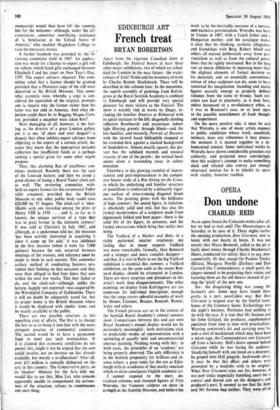French treat
EDINBURGH ART BRYAN ROBERTSON
Apart from the vigorous Canadian show at Edinburgh, the Festival boasts at least three other major exhibitions, two of which are sched- uled for London in the near future : the water- colours of Emil Nolde and the inventory of work by Charles Rennie Mackintosh. These will be described in this column later. In the meantime, the superb assembly of paintings from Kelvin- grove at the Royal Scottish Academy is confined to Edinburgh and will provide very special pleasure for most visitors to the Festival. The show is notably rich in works by Degas, in- cluding the familiar Dancers at Rehearsal with its spiral staircase to the left, diagonally slanting reflective floorboards and mysterious indoor light filtering greenly through blinds—and the less familiar, and masterly, Portrait of Duranty with the shrewd faced bibliophile slumped at his crowded desk against a stacked background of bookshelves. Almost exactly square, this pic- ture has the subdued warmth and textural vivacity of one of the-pastels : the vertical book .spines alone a resounding essay in colour mutation.
Elsewhere in this glowing roomful of impres- sionists and post-impressionists is the compul- sive Seurat study of a Boy Sitting on the Grass, in which the underlying and familiar structure of pointillism is reinforced by a delicately vigor- ous surface of criss-crossing diagonal brush marks. The painting glows with the brilliance of high summer : the seated figure, in isolation, .is absolutely solid and real,. but has also the formal inventiveness of a •sculpture made from ingeniously folded and bent paper—there is the solid life of the figure, its presence, and- the formal abstractions which bring that reality into being.
The Vuillard of a Mother and ,Baby in a -richly -patterned interior -reinforces my feeling that in many respects Vuillard was more remarkable, formally, than Bonnard and -a stronger and more complex designer— and that, if a visit to Paris to •see the big Vuillard exhibition. is essential .this summer, a Vuillard exhibition, on the same scale as the recent Bon- nard display, should be attempted in London. There are more surprises and splendours in this artist's work than disappointments. The other paintings on display from Kelvingrove are too numerous for individual description; enough that the range covers splendid examples of work by Monet, Ce.zanne, Braque, Rouault,' Renoir, Sisley and others.
The French pictures are set in the context of the Scottish Royal Academy's annual summer . show. Comparisons between this and our own _ Royal Academy's annual display would not be particularly meaningful: both institutions stick to predictable modes of representation with a • sprinkling of equally 'safe' and uncontroversial -abstract painting. Nothing wrong with this : in both cases, the principles of an 'academy' are being properly observed.,Theonly difference is in the Scottish propensity for brilliant and in- .tense. colour, a great tonic for the eye at Edin- • burgh with its avoidance of that murky tonalism which. so often constipates English academic art. I .cannot respond to the inert; de- vitalised columns •and slumped figures of Fritz Wotruba, the Viennese sculptor on -show in strength at the Scottish Museum, and believe his
work to be the inevitable outcome of a nervous and-exclusive provincialism. Wotruba was born in Vienna in 1907, with a Czech father and a Hungarian mother, and the catalogue makes it clear that his thinking, aesthetic allegiances and friendships with Berg, Robert Musil and others all steered deliberately away from pro- vincialism as well as from the cultural power blocs that he rightly mistrusted. But in the long run an innate diffidence in imposing more than the slightest elements of formal decision on his materials, and an essentially conventional notion of what sculpture can do, seem to have restricted his imagination. Standing and seated figures scarcely emerge as properly defined volumes -from the stone or bronze. Such reti- cence can lead to preciosity, as it does here; unless harnessed to a revolutionary ethos, as it was in Brancusi's case, or at least open to the possible nourishment of fresh thought and experiment.
On the -more positive side, it must be said that Wotruba is one of many artists exposed to public exhibition whose work, essentially intimate, loses any -robustness it may possess the moment it is massed .together in a de- humanised context. Some individual works by Wotruba have shown considerable presence and authority, and projected more convincingly than this sculptor's attempt to make something slack and relaxed also convey just enough structural tension for it to inhabit its space with vitality, however rarefied.


































 Previous page
Previous page